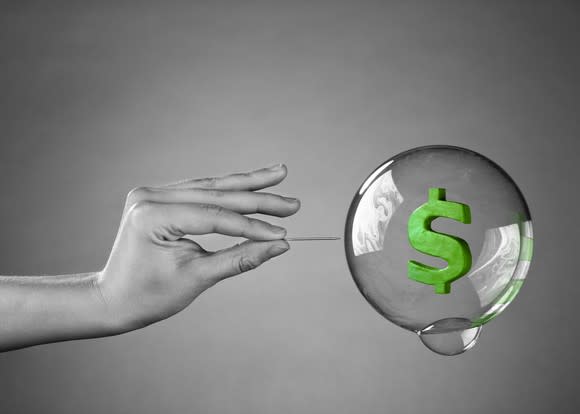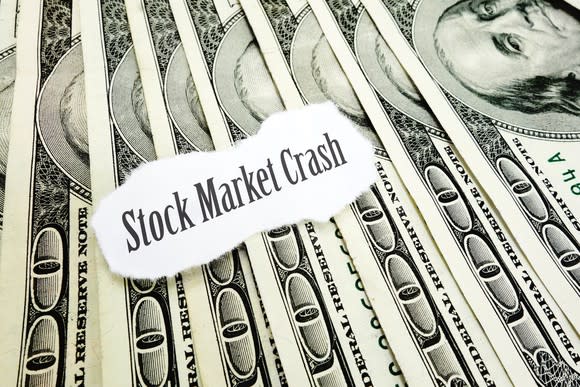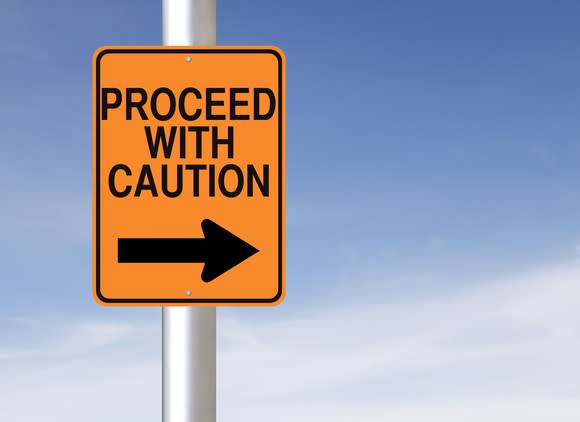A Market Crash Is Inevitable -- Here's What to Do
If you're a stock investor, you probably think about market crashes from time to time, and there's a good chance that you dread them. After all, it's natural to get excited watching the value of your holdings rise -- but you're likely also occasionally imagining a big chunk of your gains disappearing if the market tanks.
The bad news is that it's nearly a sure thing that the market will crash one of these days -- perhaps in a year or two, or perhaps tomorrow. The good news is that you can take some steps now to prepare for a crash, and you can have a plan in place for what you'll do when a crash happens.

Image source: Getty Images.
Why you should expect a market crash
The reason a stock market crash is virtually inevitable is that so far in our market's history, there have been always been crashes every now and then. Check out some recent history:
Year | S&P 500 Return |
|---|---|
2000 | (9.03%) |
2001 | (11.85%) |
2002 | (21.97%) |
2003 | 28.36% |
2004 | 10.74% |
2005 | 4.83% |
2006 | 15.61% |
2007 | 5.48% |
2008 | (36.55%) |
2009 | 25.94% |
2010 | 14.82% |
2011 | 2.10% |
2012 | 15.89% |
2013 | 32.15% |
2014 | 13.52% |
2015 | 1.38% |
2016 | 11.77% |
2017 | 21.64% |
2018* | 5.25%* |
Source: Professor Aswath Damodaran, New York University.
*Year to date as of Nov. 7, 2018.
The table shows volatility. Most years sport gains, but four of the 19 years feature losses. You can also see that while the stock market's average annual gain over many decades has approached 10%, that's rarely near the actual return of any particular year. Instead, there might be a big or small loss or gain.
The S&P 500 ended 1999 at 1,469 and was recently at 2,814. That's an increase of 92% -- almost doubling -- over the nearly 19 years represented in the table, and it represents an average annual gain of about 3.5%. That's well below the average annual gain, driving home the lesson that over any particular investment period, your average returns may be well above or below average.

Image source: Getty Images.
Here's another instructive table, summarizing major bear markets since the one that began in 1929, triggering the Great Depression:
Bear Market Start | Bear Market End | Approximate Duration | S&P 500 Decline |
|---|---|---|---|
September 1929 | June 1932 | 33 months | 86.2% |
March 1937 | April 1942 | 61 months | 60% |
May 1946 | June 1949 | 37 months | 29.6% |
August 1956 | October 1957 | 14 months | 21.5% |
December 1961 | June 1962 | 6 months | 28% |
February 1966 | October 1966 | 8 months | 22.2% |
November 1968 | May 1970 | 18 months | 36.1% |
January 1973 | October 1974 | 21 months | 48.2% |
November 1980 | August 1982 | 21 months | 27.1% |
August 1987 | December 1987 | 4 months | 33.5% |
July 1990 | October 1990 | 3 months | 19.9% |
March 2000 | October 2002 | 19 months | 49.1% |
October 2007 | March 2009 | 17 months | 56.8% |
Data source: S&P Dow Jones Indices data, via kiplinger.com.
You can see that while there are plenty of very sizable declines in the stock market's history, most of them didn't last very long. Typically, they lasted less than two years -- and then were followed by recoveries.
What not to do in the face of a market crash
A key takeaway from these tables is that you shouldn't worry too much about occasional stock market crashes. An exception would be if you plan to take your money out of the stock market in the next five or so years. In that case, don't keep that money in stocks, as anything can happen at any time. The stock market is for long-term investments.
You should also be ready to remain rational in the face of a market crash, not succumbing to panic. Lots of less sophisticated or less disciplined investors will be panicking and selling stocks -- that's what makes the crash.
Also, be sure you're focused on percentages, not points, when thinking about stock market movements. This is something the media doesn't sufficiently understand, often reporting market drops in points instead of percentages. As an example, the Dow Jones Industrial Average dropped by a whopping 1,175 points in a single day in February 2018, which sure sounds like a lot -- especially compared with 1987's "Black Monday," when the Dow fell 508 points. But in percentage points, it was a meaningful yet not catastrophic 4.6% decline -- while 1987's drop wiped out 22.6% of the market's value at the time. The Dow was near 26,000 at the time of this writing, and the S&P 500 was around 2,800. At those levels, if the Dow "plunges" by 260 points, remember that it would be just a 1% move. Even a 1,000-point drop would be just a 3.85% decline.
Finally, don't think you can avoid market crashes by getting out of stocks before one. That's "market timing," and it rarely works. Index-fund pioneer John Bogle has quipped, "Sure, it'd be great to get out of stocks at the high and jump back in at the low... [but] in 55 years in the business, I not only have never met anybody who knew how to do it, I've never met anybody who had met anybody who knew how to do it."
Various studies have supported that position. Index Fund Advisors, for instance, noted that in the 20 years from 1994 through 2013, the S&P 500 averaged an annual return of 9.2 percent, enough to turn a $10,000 initial investment into $58,352. But any investor who missed the 10 days with the biggest gains would see their average return fall to 5.5 percent and their final total fall to $29,121. Those who engage in market timing may be out of the market after downturns, missing some of the best days while waiting for a recovery to be clearly under way.

Image source: Getty Images.
What to do before a market crash
So what should you do, if you're anticipating a market crash, even if it turns out to be several years away? You have two key options: You might take some strategic actions... or you might just do nothing. There's a good case to be made for doing nothing. Simply expect occasional market downturns and ride them out.
It can be hard to do nothing, though, and there are some steps you can take that could help you make the most of a market crash:
No. 1: Do build a cash pile
Obviously, if the market crashes, it's a good time to go shopping for bargains. The stocks tied to lots of wonderful businesses are likely to be depressed -- perhaps significantly so. But if you don't have some ready cash (or access to cash) to take advantage of that, you could be out of luck. Or you might find yourself selling out of some stocks at depressed prices (thus realizing losses or shrunken gains) in order to snap up shares of more compelling stocks. That's not ideal.
So aim to build a war chest for a future market meltdown by accumulating cash. It's probably best not to overdo it, though, because the market may not crash for another few years, in which time all the cash you've amassed will not have been growing for you in stocks. You might just accumulate enough cash to establish meaningful positions in a few stocks. In general, it can be good to have no more than 10% of your overall net worth in cash for investments.
No. 2: Do build a watch list
It's not enough to have a pile of cash to spend when the market crashes if you end up having no idea what to buy. So build and maintain a stock watch list. Start by jotting down the names of companies you read or hear about that seem like promising investments. You could do so on paper, but maintaining a list online is better. You can set up an online watch list or "portfolio" full of stocks of interest at sites such as finance.yahoo.com, morningstar.com, marketwatch.com and others. You might pretend that you bought one or more shares of each at the stock price at which you first noticed the company. That way, the portfolio will always reflect how much the stock has risen or fallen since then.
Meanwhile, research and follow the companies on your list and get to know them well. Develop a strong understanding of just how they make their money, what their sustainable competitive advantages are, what their competition looks like, what their growth potential looks like, and how financially strong they are, such as in terms of cash and debt. When the market crashes, you'll be familiar with a bunch of companies and will have a sense of which are most compelling, growing most briskly and priced attractively. Monitoring your list regularly can help you notice when a company of interest, but not the overall market, falls in price significantly, presenting a possibly great buying opportunity.
No. 3: Do consider defensive stocks
Another thing you can do if you're anticipating a market crash is to include a bunch of defensive stocks in your portfolio, as they tend to get less punished during a market downturn. Defensive stocks belong to companies whose fortunes aren't very tied to the economy's movements. For example, people might put off buying refrigerators or cars during a recession, but they'll still buy groceries, socks, soaps, gas, medicine, electricity and diapers. Thus, food, tobacco, energy, and pharmaceuticals are some defensive industries, seen as more stable than their "cyclical" counterparts, such as the homebuilding, steel, automobile, and airline industries. You don't have to avoid cyclical industries in your investing, but know that they can move sharply in relationship to the economy.
No. 4: Do assess your portfolio
It's good to examine your overall portfolio regularly, to make sure it's structured as you want it to be and that you're holding the stocks you want in the proportions you want. For example, if one holding has grown far faster than others, it may now make up a very big portion of your portfolio. Ask yourself if that's OK, and consider paring back that position at least some, especially if the stock seems significantly overvalued. You don't want too many eggs in one basket.
What to do after the market crashes
Market crashes present great shopping opportunities for those who are ready for them. Consulting your trusty watch list, you'll be reminded of all the stocks you're interested in buying, and you can see how far they've fallen, too. You're likely to run across some other stocks to consider, also, when reading, watching, or listening to financial media.
One particular kind of stock to give special consideration to are dividend-paying stocks. That's because they can simply be great investments on their own and also because when they fall in price, their dividend yields get pushed up. That's a matter of simple math, because a dividend yield is just a fraction -- a stock's total annual dividend divided by its recent stock price. As a simple example, imagine a company that pays out $0.25 per quarter per share, or $1 per year per share. Imagine that it's trading for $50 per share pre-crash and that it falls to $40 post-crash. The dividend stays the same -- though companies in deep trouble may indeed cut or eliminate their dividend. Divide $1 by $50 and you'll get 0.02, or a 2% dividend yield. Divide $1 by $40, and you'll get 0.025, or a 2.5% yield. If the stock falls in half, to $25 per share, its dividend yield will be 4%. That's why market downturns can be great for dividend investors -- not only are dividend yields boosted, but depressed stock prices can also be bargains, with the promise of growth when the market recovers.
Previously high-flying growth stocks can also present good bargains during crashes, because just as outsized optimism drove their prices high before the crash, outsized pessimism can sometimes push them down further than the overall market's decline. Just be sure to have studied any such stock you buy so that you know what you're getting.
Good, seasoned investors know to expect occasional market crashes and they also know how they'll handle them -- perhaps by being ready with cash and a shopping list or perhaps just doing nothing.
More From The Motley Fool
The Motley Fool has a disclosure policy.

 Yahoo Finance
Yahoo Finance 